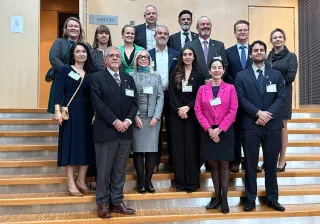Process modelling and simulation offer substantial cost savings in validating industrial processes. As new equipment and research often require significant investments, the validation process for new solutions has to be both fast and bulletproof. The benefits of modelling and simulation are clearly visible in phases ranging from early R&D to the optimisation of an operational plant.
In this article, we’ll cover
- what process modelling and simulation are
- what their benefits are
- who can utilise modelling and simulation
- how they are used in R&D, project proposals, deliveries and production optimisation.
From dynamic models to steady-state – Which approach should you choose?
First, let’s distinguish between modelling and simulation:
- Modelling is the construction of an accurate, often mathematical, representation of a system or process.
- Simulation makes calculations of how changes in the system model should affect an industrial process.
There is a clear link between the two: In order to do successful simulations, you need a well-constructed model that defines the process behaviour as accurately as possible.
There are various models for different purposes, ranging from studying molecular changes to more general models that cover plant-wide effects. The two basic modelling categories are:
- Dynamic models which analyse the time dependency of the phenomena in a system. For example, how does a change in operating conditions gradually affect process tank levels under the selected process control scheme?
- Steady-state models which focus on the final process balances instead of the transients during a specific period of time. For example, what is the result when you install a new filter in your production line?
Dynamic modelling is slow, in general, as each time step needs to be evaluated. Steady-state modelling, on the other hand, creates an estimate faster because the time dependency of phenomena is not usually calculated. Both approaches are used in industrial settings to complement each other, but in this article we will mainly cover steady-state as it offers an efficient fast-track to the analysis of potential solutions.
Process modelling and simulation validate solutions efficiently
Modelling and simulation offer various benefits to your operation. The four key benefits are:
- Speed: Modelling and simulation allow you to calculate changes in complex systems in a few seconds. You can thus analyse a large set of scenarios efficiently to support your decision making.
- Resource savings: Simulation results can steer an industrial process to significantly reduce the consumption of energy or raw material, thus increasing production efficiency.
- Flexibility: Many competing solutions can be tested simultaneously before arriving at a decision and making an investment.
- Predictability: The whole lifecycle of a plant or a piece of equipment can be analysed beforehand with simulations, which helps you to make decisions based on data.
Players across the board benefit from simulation and modelling
Simulation and modelling are versatile tools and can be used across industries for different purposes. Some industries that utilise them are:
- Engineering consultancy businesses that often want to focus on the big picture of a project, such as management or technical process design.
- Production facilities that are always looking for ways to optimise their processes, improve their cost efficiency and to meet regulations through reducing emissions.
- Equipment manufacturers that need to analyse all the viable avenues in the development process of a new solution.
- Non-profit organisations that are looking for innovation that could benefit their region, field or cause.
Simulations expedite research and development
High-quality process R&D is time consuming and expensive, and only the most promising projects are upscaled for commercial use. A well-defined validation process is required to distinguish between the projects that should be dropped and the ones that ultimately make it to production.
In the research and development phase, lab tests usually play a key role in defining how well solutions perform. The lab environment, however, always leaves gaps, as everything can’t be tested in a flask. By utilising simulation to complement the lab work, you can upscale the tests from a lab experiment to a plant-scale solution.
Fast project proposals and holistic deliveries
When a customer sends out a request for proposal on a new solution or production line, you have to come up with a tangible project proposal in a matter of days or even hours. This includes calculating mass and energy balances and making cost estimates.
Existing model libraries and simulation expedite the offer creation considerably. Even if standard models are available, there are often so many variables in action that creative simulations are necessary to make an offer accurate enough.
When you have completed a project and it is time for project delivery, a digital twin can greatly support in the inevitable future optimisation projects. A digital twin is a complete mathematical model of an industrial system, such as a plant.
When the customer wants to change something in their system, they can easily run simulations that show the effects of the proposed changes. This way, adhering to regulation no longer requires charting the whole system first, as an up-to-date digital twin of the system already exists.
Simulation supports plant optimisation and regulatory compliance
Plants need to be optimised constantly because of competition and changing regulations. Also, plants facing potential shutdown need a vision for the future, which can often come through surprising optimisation projects.
Modelling and simulation are risk-free ways to experiment with new solutions that could make the production process more efficient or environmentally friendly. At plant level, measuring everything with sensors is impossible. Simulation helps to discover the low-hanging fruits that could bring significant benefits with modest investments.
Broaden your knowledge with our process simulation guide
If you are interested in learning more about process modelling and simulation, read our thorough guide on the subject. In the guide, we will dig deeper into the topics covered in this article, along with providing concrete reference cases and giving tips on what you should consider when choosing a modelling and simulation partner.
If you’re looking for a holistic partner that can support you in your simulation needs from research to plant optimisation, contact us.




